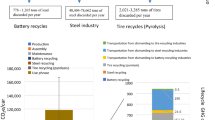Abstract
By the application of life cycle assessment (LCA) methodology, this paper estimates the environmental impacts of production and disposal of traction motors used in electric vehicles in China. The results show that the total energy use, the criteria emissions and the greenhouse gases (GHG) emissions of a traction motor production and disposal are about 2,899,MJ, 4.5,kg and 259.5,kg per motor, respectively. Among the regulated emissions, the SO x emission ranks first by total mass, followed by CO, PM10, NO x , PM2.5, and volatile organic compound (VOC). The motor material production stage accounts for most of the energy consumption and emissions, followed by the assembly stage and the end-of-life disposal stage. In this study, the environmental performance analysis is extended to the comparison between the use of secondary material and primary material for the material production stage. It is found that using 100% secondary material results in a 52.9% reduction in energy consumption, a 49.8% reduction in regulated emissions, and a 49.3% reduction in GHG emissions compared with the use of 100% primary material.
Similar content being viewed by others
References
International Energy Agency (IEA). World Energy Outlook 2011 [R]. 2011.
Carbon Dioxide Information Analysis Center (CDIAC). People’s Republic of China Fossil-Fuel CO2 Emissions [EB/OL]. http://cdiac.ornl.gov/trends/emis/tre_prc.html, 2009-10-12.
Ou X, Zhang X, Chan S. Alternative fuel buses currently in use in China: Life-cycle fossil energy use, GHG emissions and policy recommendations [J]. Energy Policy, 2010, 38(1): 406–418.
State Council of China. “Twelfth Five-year” National Strategic Emerging Industry Development Plan [R]. 2012(in Chinese).
Bonollo F, Carturan I, Cupito G et al. Life cycle assessment in the automotive industry: Comparison between aluminium and cast iron cylinder blocks [J]. Metallurgical Science and Technology, 2006, 24(2): 3–8.
Li S, Li N, Li J et al. Vehicle cycle energy and carbon dioxide analysis of passenger car in China [J]. AASRI Procedia, 2012, 2: 25–30.
Simões C L, Pinto L M C, Bernardo C A. Modelling the environmental performance of composite products: Benchmark with traditional materials [J]. Materials and Design, 2012, 39: 121–130.
Burnham A, Wang M, Wu Y. Development and Applications of GREET 2.7-The Transportation Vehicle-Cycle Model [M]. Energy Systems Division, Argonne National Laboratory, 2006.
International Standard Organisation. ISO 14040: 1997 Environmental Management — Life Cycle Assessment-Principles and Framework [S]. Geneva, Switzerland, 1997.
Michalek J J, Chester M, Jaramillo P et al. Valuation of plug-in vehicle life-cycle air emissions and oil displacement benefits [J]. Proceedings of the National Academy of Sciences, 2011, 108(40): 16554–16558.
International Standard Organisation. ISO 14043: 2000 Environmental Management — Life Cycle Assessment-Life Cycle Interpretation [S]. Geneva, Switzerland, 2000.
Gao L, Winfield Z C. Life cycle assessment of environmental and economic impacts of advanced vehicles [J]. Energies, 2012, 5(3): 605–620.
Vinodh S, Jayakrishna K. Environmental impact minimisation in an automotive component using alternative materials and manufacturing processes [J]. Materials and Design, 2011, 32(10): 5082–5090.
Weiss M A, Heywood J B, Schafer A et al. Comparative Assessment of Fuel Cell Cars [R]. MIT Report LFEE 2003-001 RP, 2003.
Schuckert M, Saur K, Florin H et al. Life cycle analysis: Getting the total picture on vehicle engineering alternatives [J]. Automotive Engineering, 1996, 104(3): 49–52.
Dubreuil A, Bushi L, Das S et al. A comparative life cycle assessment of magnesium front end autoparts [C]. In: SAE 2010-01-0275, 2010.
Bossel U. Well-to-Wheel Studies, Heating Values, and the Energy Conservation Principle [R]. European Fuel Cell Forum, Switzerland, 2003.
Maduro M. Well-to-Wheel Greenhouse Gas Emissions and Energy Electrified Vehicles in Canada and the U. S. [D]. University of Ontario Institute of Technology, CA, 2010.
International Standard Organisation. ISO 14040:2006 Environmental Management — Life Cycle Assessment-Principles and Framework [S]. Geneva, Switzerland, 2006.
International Standard Organisation. ISO 14044:2006 Environmental Management — Life Cycle Assessment-Requirements and Guidelines [S]. Geneva, Switzerland, 2006.
China National Standard. GB/T 24040-2008 Environmental Management — Life Cycle Assessment-Principles and Framework [S]. Beijing, China, 2008 (in Chinese).
China National Standard. GB/T 24044-2008 Environmental Management — Life Cycle Assessment-Requirements and Guidelines [S]. Beijing, China, 2008 (in Chinese).
Lipman T E, Delucchi M A. Emissions of nitrous oxide and methane from conventional and alternative fuel motor vehicles [J]. Climatic Change, 2002, 53(4): 477–516.
GREET. GREET model[EB/OL]. http://greet.es.anl.gov/, 2009-10-12.
Editing Committee of China Electric Power Yearbook. China Electric Power Yearbook 2010 [M]. China Electric Power Press, Beijing, 2010 (in Chinese).
Intergovernmental Panel on Climate Change (IPCC). IPCC Fourth Assessment Report: Climate Change 2007 [R]. 2007.
Author information
Authors and Affiliations
Corresponding author
Additional information
Supported by National High Technology Research and Development Program of China (“863” Program, No. 2011AA11A288).
Li Shuhua, born in 1989, female, doctorate student.
Rights and permissions
About this article
Cite this article
Li, S., Li, J., Li, N. et al. Evaluation of environmental impacts of traction motor production and disposal. Trans. Tianjin Univ. 19, 413–418 (2013). https://doi.org/10.1007/s12209-013-2106-5
Accepted:
Published:
Issue Date:
DOI: https://doi.org/10.1007/s12209-013-2106-5




